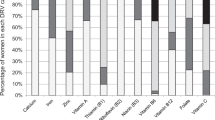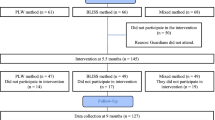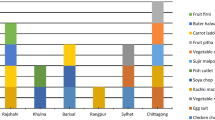Abstract
Objective: The objectives of this study were to estimate the quantity and nutritive quality of the complementary diet in rural Malawi, and to identify feeding practices, nutrients and dietary modifiers of iron and zinc bioavailability that may limit the quality of the diet.
Design: This cross-sectional study design included an anthropometric survey, a feeding practices questionnaire, and an interactive, 24 h recall dietary data survey.
Setting: Four rural villages in Balaka district, southern Malawi.
Subjects: Mothers resident in the study communities with breastfed children aged up to 24 months were eligible.
Results: Stunting was prevalent among these weanlings. Maize was the predominant food source, with limited contribution of animal foods. Deficits in dietary energy and several nutrients were found when compared to estimated needs. When expressed per kg body weight, energy intakes appeared adequate. The bioavailability of zinc was low due to a high phytate:zinc molar ratio. Iron bioavailability was also low due to low intake of absorption enhancers such as meat/fish/poultry protein and ascorbic acid. Dietary quality was poorest for 6 to 8-month-old infants.
Conclusions: Iron, zinc and calcium were the most limiting nutrients to the quality of the diet, partly exacerbated by the poor bioavailability of iron and zinc. Increased total intake and bioavailability of iron and zinc would improve the complementary diets.
Sponsorship: This study was funded by the Thrasher Research Fund, Salt Lake City, Utah, USA.
European Journal of Clinical Nutrition (2001) 55, 841–849
This is a preview of subscription content, access via your institution
Access options
Subscribe to this journal
Receive 12 print issues and online access
$259.00 per year
only $21.58 per issue
Buy this article
- Purchase on Springer Link
- Instant access to full article PDF
Prices may be subject to local taxes which are calculated during checkout
Similar content being viewed by others
References
Allen LH (1993) The Nutrition CRSP: what is marginal malnutrition, and does it affect human function? Nutr. Rev. 51 255–267
Allen LH, Black, AK, Backstrand JR, Pelto GH, Ely RD, Molino E & Chavez A (1991) An analytical approach for expoloring the importance of dietary quality versus quantity in the growth of Mexican children Food Nutr. Bull. 13 95–109
Brown KH, Black RE, Becker S, Nahar S & Sawyer J (1982) Consumption of foods and nutrients by weanlings in rural Bangladesh Am. J. Clin. Nutr. 36 878–889
Brown KH, Dickin KL, Bentley ME, Oni GA, Obasaju VT, Esrey SA, Mebrahtu S, Alade I & Stallings RY (1988) Consumption of weaning foods from fermented cereals in Kwara state, Nigeria In Improving Young Child Feeding in Eastern and Southern Africa. Household-level Food Technology, eds. D Alnwick, S Moses & OG Schmidt 181–197 Ottawa: International Development Research Centre
Brown KH, Black RE, Lopez de Romana G & Creed de Kanashiro H (1989) Infant-feeding practices and their relationship with diarrheal and other diseases in Huascar (Lima), Peru Pediatrics 83 31–40
Brown KH, Peerson JM & Allen LH (1998) Effect of zinc supplementation on children's growth: a meta-analysis of intervention trials Bibl. Nutr. Dieta 54 76–83
Butte NF (1996) Energy requirements of infants Eur. J. Clin. Nutr. 50 (Suppl 1), S24–S36
Butte NF, Garza C, Stuff JE, O'Brian Smith E & Nichols BL (1984) Effect of maternal diet and body composition on lactational performance Am. J. Clin. Nutr. 39 296–306
Cook JD, Reddy MB, Burri J, Juillerat MA & Hurrell RF (1997) The influence of different cereal grains on iron absorption from infant cereal foods Am. J. Clin. Nutr. 65 964–969
Dean AG, Dean AJ, Coulombier D, Burton AH, Brendel KA, Smith DC, Dicker RC, Sullivan KM & Fagan RF (1994) Epi Info, Version 6: a Word Processing Database, and Statistics Program for Epidemiology on Microcomputers Atlanta, GA: Centers for Disease Control and Prevention
de Carvalho M, Robertson S, Merkatz R & Klaus M (1982) Milk intake and frequency of feeding in breast-fed infants Early Hum. Devl. 7 155–163
Drost NM (1999) Transforming social, gendered practices affecting malnutrition: action research in Malawi Doctoral dissertation Department of Sociology and Equity Studies in Education, Ontario Institute for Studies in Education, University of Toronto
FAO/WHO (1988) Requirements of Vitamin A, Iron, Folate and Vitamin B-12: Report of a Joint FAO/WHO Expert Consultation FAO Food Nutr Ser no. 23. Rome: FAO
FAO/WHO/IAEA (1996) Trace Elements in Human Nutrition and Health Geneva: WHO
Ferguson EL (1992) A comparison of the seasonal food consumption patterns and zinc status of preschool children living in rural areas of Southern Malawi and Southern Ghana Unpublished Doctoral dissertation. Division of Applied Nutrition, University of Guelph.
Ferguson EL, Gibson RS, Thompson LU & Ounpuu S (1989) Dietary calcium, phytate, and zinc intakes and the calcium phytate and zinc molar ratios of the diets of a selected group of East African children Am. J. Clin. Nutr. 50 1450–1456
Ferguson EL, Gibson RS, Opare-Obisaw C, Ounpuu S, Thompson LU & Lehrfeld J (1993) The zinc nutriture of preschool children living in two African countries J. Nutr. 123 1487–1496
Ferguson EL, Gadowsky SL, Huddle J-M, Cullinan TR, Lehrfeld J & Gibson RS (1995) An interactive 24-h recall technique for assessing the adequacy of trace mineral intakes of rural Malawian women; its advantages and limitations Eur. J. Clin. Nutr. 49 565–578
Gibson RS (1994) Zinc nutrition in developing countries Nutr. Res. Rev. 7 151–173
Gibson RS & Ferguson EL (1998) Nutrition intervention strategies to combat zinc deficiency in developing countries Nutr. Res. Rev. 11 115–131
Gibson RS & Huddle J-M (1998) Suboptimal zinc status in pregnant Malawian women: its association with low intakes of poorly available zinc, frequent reproductive cycling, and malaria Am. J. Clin. Nutr. 67 702–209
Gibson RS & Hotz C (2001) Nutritional causes of linear growth faltering in infants during the complementary feeding period In Nutrition and Growth, 47th Nestle Nutrition Workshop Series, eds. R Martorell & F Haschke. Pennsylvania, PA: Lippincott Williams & Wilkins, (in press).
Gibson RS, Ferguson EL & Lehrfeld J (1998) Complementary foods for infant feeding in developing countries: their nutrient adequacy and improvement Eur. J. Clin. Nutr. 52 764–770
Hallberg L & Hulthen L (2000) Prediction of dietary iron absorption: an algorithm for calculating absorption and bioavailability of dietary iron Am. J. Clin. Nutr. 71 1147–1160
Hautvast JLA, van der Heijden LJM, Luneta AK, van Staveren WA, Tolboom JJM & van Gastel SM (1999) Food consumption of young stunted and non-stunted children in rural Zambia Eur. J. Clin. Nutr. 53 50–59
Institute of Medicine (1991) Nutrition During Lactation Washington, DC: National Academy Press
Krebs NF & Hambidge KM (1986) Zinc requirements and zinc intakes of breastfed infants Am. J. Clin. Nutr. 43 288–292
Krebs NF, Reidinger CJ, Miller LV, Fennessey PV & Hambidge KM (1993) Whole body zinc metabolism in breastfed infants FASEB J. 7 A153 (abstract )
Lohman TG, Roche AF & Martorell R (eds) (1988) Anthropometric Standardization Reference Manual Champaigne, IL: Human Kinetic Books
Lozoff B, Jimenez E & Wolf AW (1991) Long-term developmental outcome of infants with iron deficiency New Engl. J. Med. 325 687–694
Monsen ER, Hallberg L, Layrisse M, Hegsted DM, Cook JD, Mertz W & Finch CA (1978) Estimation of available dietary iron Am. J. Clin. Nutr. 31 134–141
Morris ER & Ellis R (1989) Usefulness of the dietary phytic acid/zinc molar ratio as an index of zinc bioavailability to rats and humans Biol. Trace Elem. Res. 19 107–117
Murphy SP, Beaton GH & Calloway DH (1992) Estimated mineral intakes of toddlers: predicted prevalence of inadequacy in village populations in Egypt, Kenya and Mexico Am. J. Clin. Nutr. 56 565–572
National Statistical Office, Malawi (1994) Malawi Demographic and Health Survey Zomba: National Statistical Office
Paul AA, Bates CJ, Prentice A, Day KC & Tsuchiya H (1998) Zinc and phytate intake of rural Gambian infants: contributions from breastmilk and weaning foods Int. J. Food Sci. Nutr. 49 141–155
Pelletier DL, Frongillo EA & Habicht J-P (1993) Epidemiologic evidence for a potentiating effect of malnutrition on child mortality Am. J. Public Health 83 1130–1133
Prentice A & Bates CJ (1993) An appraisal of the adequacy of dietary mineral intakes in developing countries for bone growth and development in children Nutr. Res. Rev. 6 51–69
Sandberg A-S, Brune M, Carlsson N-G, Hallberg L, Skoglund E & Rossander-Hulthén L (1999) Inositol phosphates with different numbers of phosphate groups influence iron absorption in humans Am. J. Clin. Nutr. 70 240–246
Schroeder DG & Brown KH (1994) Nutritional status as a predictor of child survival: summarizing the association and quantifying its global impact Bull. WHO 72 569–579
Torun B, Davies PSW, Livingstone MBE, Paolisso M, Sackett R & Spurr GB (1996) Energy requirements and dietary energy recommendations for children and adolescents 1 to 18 y old Eur. J. Clin. Nutr. 50 (Suppl 1), S27–S81
Underwood BA (1994) Maternal vitamin A status and its importance in infancy and early childhood Am. J. Clin. Nutr. 59 (Suppl), S517–S524
van Steenbergen WM, Kusin JA, Kardjati S & Renqvist UH (1991) Nutritional transition during infancy in East Java, Indonesia: 1. A longitudinal study of feeding pattern, breast milk intake and the consumption of additional foods Eur. J. Clin. Nutr. 45 67–75
Victora CT, Kirkwood BR, Ashworth A, Black RE, Rogers S, Sazawal S, Campbell H & Gove S (1999) Potential interventions for the prevention of childhood pneunomia in developing countries: improving nutrition Am. J. Clin. Nutr. 70 309–320
WHO (1997) WHO Global Database on Child Growth and Malnutrition Geneva: WHO
WHO (1998) Complementary Feeding of Young Children in Developing Countries: a Review of Current Scientific Knowledge Geneva: WHO
Wise A (1995) Phytate and zinc bioavailability Int. J. Food Sci. Nutr. 46 53–63
Acknowledgements
The authors wish to thank those who supported the field work in Malawi: Department of Community Health, College of Medicine, University of Malawi, Ministries of Health and Agriculture, Liwonde, Emmanuel International, Malawi, and Fiona Yeudall for help in getting started. We also express gratitude to the field staff, A Kandulu, B Makuwira, E Jabu, F Laisani, M Katundu, M Mnalemba and C Sitambo for their efforts, and community health committee members and participants for their cooperation.
Author information
Authors and Affiliations
Corresponding author
Rights and permissions
About this article
Cite this article
Hotz, C., Gibson, R. Complementary feeding practices and dietary intakes from complementary foods amongst weanlings in rural Malawi. Eur J Clin Nutr 55, 841–849 (2001). https://doi.org/10.1038/sj.ejcn.1601239
Received:
Revised:
Accepted:
Published:
Issue Date:
DOI: https://doi.org/10.1038/sj.ejcn.1601239
Keywords
This article is cited by
-
Selection of complementary foods based on optimal nutritional values
Scientific Reports (2017)
-
Effect of micronutrient powder supplementation for two and four months on hemoglobin level of children 6–23 months old in a slum in Dhaka: a community based observational study
BMC Nutrition (2016)
-
Feeding styles of caregivers of children 6-23 months of age in Derashe special district, Southern Ethiopia
BMC Public Health (2012)
-
Microbiological quality of complementary foods and its association with diarrhoeal morbidity and nutritional status of Bangladeshi children
European Journal of Clinical Nutrition (2012)
-
Participatory nutrition education and adoption of new feeding practices are associated with improved adequacy of complementary diets among rural Malawian children: a pilot study
European Journal of Clinical Nutrition (2005)



